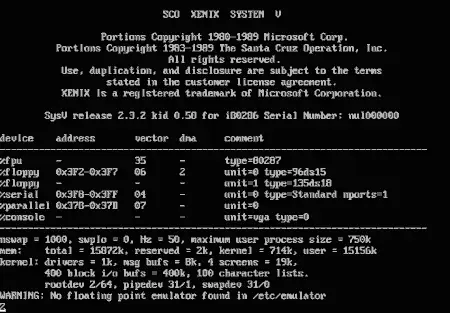
On Friday, we took note of the 40th anniversary of the official reveal of Windows 1.0 by Microsoft on November 10, 1983 (although the actual launch of the OS wouldn't happen for another two years).
Over two years before that, in August 1981, Microsoft released the first version of its MS-DOS operating system. That version wasn't technically developed by the company; it bought the rights to a previously made OS, 86-DOS, from a programmer named Tim Paterson.
However, even before those two events, Microsoft sold its first computer operating system, which was officially announced on August 25, 1980. It was called Xenix and at the time, Microsoft had hoped it would be the standard OS for the personal computer market. In the end, that didn't happen.
Similar to MS-DOS, Microsoft did not develop Xenix by itself from scratch. It was based on Unix, which was originally created by AT&T's Bell Lab. The specific version that Microsoft used as the basis for Xenix was Version 7 Unix, which first launched in 1979.
Microsoft CEO Bill Gates reportedly believed that Unix would become the standard operating system for PCs when they became powerful enough to use the. Before its collaboration with IBM to help make the software for its first IBM PC in 1981, Microsoft bought the source code license to Version 7 Unive from AT&T. However, those rights did not extend to the actual name "Unix" so Microsoft used the name "Xenix" for its first-ever OS.

The company sold Xenix to PC makers directly. Unlike MS-DOS, and later Windows, it never actually sold Xenix as its own stand alone OS to businesses or consumers. According to this blog post from Rob Ferguson, who worked for a few years on the Xenix team at Microsoft, Microsoft priced Xenix at between $2,000 to $9,000 a copy, depending on the number of users. That's over $6,000 on the low end in today's dollars.
Microsoft marketed the use of Xenix for 16-bit PC chips and applications, along with its multitasking features. OEMs had the option of offering the operating system as part of a full PC, or as an an optional extra. It was ported to work on a variety of different PC chips and architectures in the early 1980s. Many of those ports were jointly developed by Microsoft and another company, Santa Cruz Operation, better known as SCO. In 1984, SCO bought the rights to distribute Xenix in the US to consumers.
According to Ferguson's blog post, Microsoft was discussing whether or not Xenix should be the official successor to MS-DOS for 16-bit PCs around 1985. However, a couple of events happened that eventually doomed Xenix's development at the company.
One was AT&T's decision to sell a version of Unix, UNIX System V, directly to commercial users. When that happened, Microsoft felt it could not compete with the huge (at that time) AT&T.
The other was Microsoft's decision to work with IBM on another new GUI-based operating system, OS/2 (as we have mentioned before we will likely write about that some other day).

In the late 1980s, Microsoft sold off its rights to Xenix to SCO, in exchange for a small stake in the company. Ferguson wrote about a wake that was held in 1989 at Microsoft to signal the end of their direct involvement in Xenix:
Many of the old hands at MS had worked on Xenix at some point, so the party was filled with much of the senior development staff from across the company. There was cake, beer, and nostalgia; stories were told, most of which I can’t repeat. Some of the longer-serving folks dug through their files to find particularly amusing Xenix-related documents, and they were copied and distributed to the attendees.
The OS would continue to be in active development by SCO for a few more years. In fact, it released a version, Xenix System V/386, that was the first 32-bit OS that worked with x86-based chips. However, by the early 1990s, the development of the Xenix-based operating system had ended. Xenix remains an interesting footnote in Microsoft's history, and of operating systems in general.



3175x175(CURRENT).thumb.jpg.b05acc060982b36f5891ba728e6d953c.jpg)
Recommended Comments
There are no comments to display.
Join the conversation
You can post now and register later. If you have an account, sign in now to post with your account.
Note: Your post will require moderator approval before it will be visible.